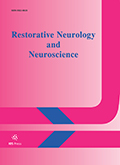Authors: Sabel, Bernhard A.
Article Type:
Research Article
Abstract:
Lesions in the central nervous system often lead to loss of vision due to visual system involvement. In the course of weeks or months, some vision can recover in rats, cats, monkeys, and humans, though it is mostly incomplete. This paper reviews the current knowledge of the under-lying neurobiological mechanism of recovery of vision, particularly those observed in adult rats with partial optic nerve crush (ONC). Immediately after ONC, rats are almost completely blind, evident by
…their inability to perform visual tasks such as brightness and pattern discrimination and they fail to orient towards small, moving targets. Within about two weeks, however, rats significantly recover some of their lost visual functions despite the fact that only about 10 % of the retinal ganglion cells (RGCs) maintain a viable connection with their brain tar-gets. Molecular, anatomical and physiological studies have identified some of the neurobiological determinants of this visual restitution. Immediately following ONC there is a massive soma swelling of about 80 % of the RGCs with subsequent cell death due to apoptosis and necrosis. The remaining 20 % survive with or without axonal connection to their target and undergo marked changes: (i) about half of these RGCs experience a moderate, reversible soma swelling, (ii) there is a loss of anterograde axonal transport in the optic nerve which partially recovers after several weeks, and (iii) many of the surviving RGCs undergo alterations in gene expression, particularly that of the NR1 recep-tor and the immediate early gene, c-jun. While these changes may be part of an adaptive program of the cells to cope with the trauma, cell sur-vival in the retina does not correlate well with subsequent recovery of vision. We have therefore also studied plasticity in the down stream denervated brain structures which are innervated by retinofugal pathways, particularly the superior colliculus. Here we found (i) recovery of metabolic activity and (ii) changes in gene expression, such as an up-regulation of the enhancer of split (R esp-1) gene. When viewed together with studies on recovery of vision and neuronal reorganization done in other laboratories it is clear that recovery of vision involves simultaneous plasticity in the damaged structure itself and, transsynaptically, in down-stream structures such as the tectum, the lateral geniculate nucleus and visual cortex. Considering both pre-clinical and clinical evidence, I propose the biological substrate underlying restoration of vision as follows: surviving neurons within areas of partial damage which corresponds clinically to transition zones located between intact and deficient visual field sectors act in concert with down-stream areas, which themselves undergo dramatic reorganization to cope with a condition of reduced, but residual input. Restitution of vision is therefore a multifactorial event of within-systems plasticity, involving neurobiological alterations along the entire retinofugal axis. It is likely that these mechanisms are also responsible for visual improvements that are seen both in animals and patients after prolonged visual restitution training.
Show more
Keywords: Recovery, rehabilitation, vision, plasticity, blindness, restitution
Citation: Restorative Neurology and Neuroscience,
vol. 15, no. 2-3, pp. 177-200, 1999




